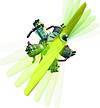Desktop product has new features and enhancements
August 2002

MSC.visualNastran 4D 2002, the latest release of this flagship desktop product, includes several new features to enhance motion and FEA capabilities, as well as ease-of-use. With new functionality in the motion core, like gears and belts. The addition of an interactive multimedia tour to teach new customers the fundamentals of the application means that customers can simulate a wider range of problems and be more productive as soon as possible.
New features include:
Getting started
The Getting Started CD is an interactive multimedia tour that guides new users through basic concepts of how to use MSC.visualNastran 4D and enables them to start their own projects. An enhanced interactive Welcome Screen has been added to help new users, and has access to the Getting Started CD, demo file previews, and a tour of new features.
Gear and belt constraint
The gear/coupler constraint models general idealised gears. Spur and bevelled gears can be modelled. Belt constraints will also be implemented in a planar fashion. Multiple gears and belt systems can be coupled for more complex motion.
FLEXIm and campus-wide licence
FLEXlm, the de facto standard, offers a more robust means of licensing the MSC.visualNastran Desktop software over a network and provides campus-wide licensing, including temporary onDemand licensing.
My vNuniverse
Allows one to change and save simulation and display settings, colours, toolbars, unit systems, and materials, all in one easy-to-get-to location, on a per-user basis for true customisation. CAD Environment Emulation - users can now customise their MSC.visualNastran 4D environment to make the toolbars and buttons function as they do in their preferred CAD system, thereby easing the transition.
Heat transfer
The heat transfer in MSC.visualNastran 4D offers the fundamental FEA capabilities for steady state thermal analysis. With this feature, users can include thermal load and boundary conditions such as volumetric heat generation, surface convection, surface radiation, surface heat flux, and prescribed temperature. Users can also provide temperature-dependent film coefficients for convection boundary conditions. Heat transfer boundary conditions can also be controlled by formulas, tables, and time functions.
Smooth contact
Engineers can accurately and quickly simulate one body rolling or sliding on another body, in three dimensions such as in cam and latch designs. Contact models perform significantly faster and with finer resolution
For more information: Estech Design Technologies, 012 991 5570.
Others who read this also read these articles
A challenge for motor manufacturers
Computer-based integration of design and manufacturing is essential for the '24-month car' to be achieved[ October 2004 ]
Prominent new lifestyle centre for Cape Town's financial district
Dimension Modeling created the 3D interior models that were then also rendered out for internal views of the apartments as well as the atrium and foyer areas[ August 2004 ]
Anglo Platinum - automating repetitive design tasks with Solid Edge
Solid Edge Insight is an innovative solution that seamlessly integrates CAD, design management and Web-based collaboration into a single tool that is easy to implement and easy to manage[ June 2004 ]
Styled plastic products and packaging - main pains and solution initiatives
To put the product and the customer front and centre, where they belong, all disciplines must sit at the same virtual table, sharing the same information and seeing the same vision[ June 2004 ]
Evolution from 2D to 3D - a product development manager's perspective: Part II
Whereas 2D CAD shortens time scales to some extent, 3D CAD goes much further, directly supporting the whole product development cycle, speeding up every activity and increasing the quality of design by removing many sources of inaccuracy and error[ April 2004 ]
Multiphysics analysis to simulate cylinder head
Adiabatics Inc used multiphysics FEA software from Algor to study the thermal and structural behaviour of a cylinder head for a diesel engine that would provide reduced heat rejection and increased power density while maintaining its superior fuel economy and lower operating cost[ December 2003 ]
Unigraphics NX 2: the next generation
What the NX 2 release sees is the integration of the use of networks of curves to define surface boundaries and existing geometry, and freeform surface modelling into the core of Unigraphics but with a few rather neat extras as well[ October 2003 ]
Geopak helps create Festival City
Geopak Site allows one to handle with ease live 'what if' scenarios with the client and other design team members[ August 2003 ]
Others who read this also read these news items
Lockheed Martin selects preferred MCAD tool
[ December 2005 ]
Grand scale initiatives at Ethekwini Municipality
[ October 2005 ]
Robert Mugabe Avenue in Windhoek gets extension
[ August 2005 ]
Strand7 nonlinear analysis used to solve bracket deformation problem
[ August 2005 ]
Scania optimises truck components
[ February 2005 ]
Delcam's PowerMILL chosen for A1 Grand Prix engine manufacture by Zytek
[ February 2005 ]
A first of its kind: irrigation development, a R3,7-billion SADC project
[ February 2005 ]
Arup lands Tianjin Olympic Aquatic Centre project
[ December 2004 ]
Others who read this also read these regulars
Search Site
Subscribe
Previous Issues
Other Technews Publications
Other Technews Buyers Guides
 |  | Copyright c1995-2009 Technews Publishing (Pty) Ltd.. All rights reserved. |